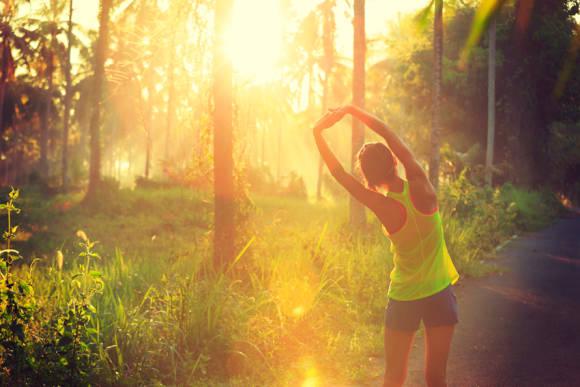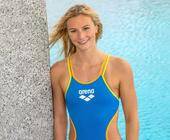Function and nature as one
02.04.2020, 15:52 Uhr
How can natural fibres be deployed for functional apparel?
How can natural fibres be deployed for functional apparel? Ulrike Arlt, former editor-in-chief of SPORTS FASHION by SAZ, spoke with her jury colleagues Alexa Dehmel, Ute Mauch and Marco Weichert about the latest trends.
by Ulrike Arlt
Although the Performance Days fair, focusing on trends in functional (sport) fabrics for summer 2022, cannot take place live in Munich this April, the fair has nevertheless found a way to present upcoming trends in such fabrics. Exhibitors who wished to present their latest products in April had submitted more than 1,000 fabrics in the run-up to the fair in order to take part in the Performance Forum with their innovative highlights. Despite the exceptional circumstances, members of the Performance Days jury viewed the fabrics separately and then determined the final selection for the Performance Forum so that the highlights can now be shown in a virtual form.
On the “Digital Fair” platform on the website www.performancedays.com, the fair presents the 240 most exciting new developments in functional fabrics for enthusiastic visitors. In line with the fair’s focus topic “Inspired by nature”, the focus is on functional, sustainable fabrics that make use of natural fibres or natural additives. Jury member Ulrike Arlt, former editor-in-chief of SPORTS FASHION, spoke with her jury colleagues Alexa Dehmel, Ute Mauch and Marco Weichert about the latest trends.
SPORTS FASHION: What are the trends in summer 2022 for functional fabrics? What were your personal highlights in the selection of the fabrics for the Forum?
Alexa Dehmel: The whole development towards sustainability and nature is particularly impressive. Natural fibres will also be used for performance purposes in the future. Natural finishes, alone or in combination with bio-based or recycled synthetic fibres, are demonstrating a new, sustainable approach in the development of apparel.
Marco Weichert: Natural fibres, or fibres with natural ingredients embedded in the yarns, are becoming increasingly important, especially for the sportswear market. Natural fibres are being deployed in a targeted manner according to their function, whereby nature and function are no longer counterparts in summer 2022.
Ute Mauch: Textile factories are developing a variety of creative fabrics made from natural fabrics and natural fibre blends, which are lightweight and pleasant to wear and easy to care for, and which meet a new demand for the sensation of wearing comfort. This results in garments for everyday use, which can be worn for everything from sports activities to leisure and work, and which have been developed within the modern context of sustainable design.
Ute Mauch: Textile factories are developing a variety of creative fabrics made from natural fabrics and natural fibre blends, which are lightweight and pleasant to wear and easy to care for, and which meet a new demand for the sensation of wearing comfort. This results in garments for everyday use, which can be worn for everything from sports activities to leisure and work, and which have been developed within the modern context of sustainable design.
This season’s focus topic is called “Inspired by nature”. What type of innovation is there in terms of “natural function”?
Mauch: The variety of new fabrics is incredible. In the new Performance Forum, there are interesting fabrics made of paper, hemp, linen and Tencel blends that are natural and offer functional benefits. It’s also exciting to see extracts of algae, oyster shells and collagen from fish scales being integrated into yarns. A recent interesting development is the cooling effect of ground jade, which can be incorporated into the yarns.
Dehmel: In the Focus Topic category, I was especially impressed by the aforementioned blends of natural fibres, such as paper yarn with sea-wool, bamboo with hemp, viscose with cashmere or organic merino with alpaca. All these blends offer many natural functions such as rapid moisture transport, the neutralisation of unpleasant odours or particularly good climate management properties. In addition, these blends have a particularly pleasant haptic. The colourfulness also reflects the naturalness, often achieved with the use of organic colours or with the fibres retaining their natural colours, in particular with merino and alpaca.
Are all (natural) fibres suitable for all areas of sporting application? Or do they differ?
Are all (natural) fibres suitable for all areas of sporting application? Or do they differ?
Mauch: Of course, a distinction must be made here, not every fibre has the same properties. There are beauty finishes such as argan oil or collagen that care for the skin – this is certainly more interesting for yogawear than for running or outdoorwear. For more sweat-inducing sports good moisture transport is more the priority – and here, hemp is nature’s new super fibre for this purpose, along with its antibacterial and durability properties. Cotton, which we also have in mixed qualities in the Forum, is in contrast less suitable due to the longer drying times.
Dehmel: For yoga, there are some beautiful natural fibre combinations and finishes in the base-layer segment. The use of recycled elastane (Roica) is a nice sustainable development. For jogging, ski touring or other sweat-inducing sports, in the mid-layer segment for example, I would rather recommend technical 3D developments made of chemical fibres or a chemical fibre mix. There are also sustainable solutions, for example fabrics made of recycled polyamide or polyester. For some of them, the raw materials are partly fished out of the sea as waste, as is the case with the “sea wool” fibre. Or in the case of fabrics made of polyesteramide: these are biodegradable synthetic materials which, under certain anaerobic conditions, decompose on landfills or even in seawater. Bio-based chemical fibres such as polyamide made from the oil of the castor bean also contribute to sustainability.
How can waterproof, breathable fabrics become environmentally friendly? Are there natural solutions that work here?
How can waterproof, breathable fabrics become environmentally friendly? Are there natural solutions that work here?
Weichert: Only beeswax is in fact natural as a water-repellent method. The C0 finishes are environmentally friendly, yet they do not have their origins in nature. WWA laminates are also sustainable when made of mono-materials, in cases where the outer fabric, membrane and lining are made of 100 percent recycled polyester. This is because these materials can be recycled and thus close the textile cycle.
Dehmel: There is another point that needs to be mentioned: In the case of chemical fibres, i.e. the recycled polyester qualities shown at the Forum, sustainable dyeing methods such as “e-dye”, “dope dye” or “solution dye” are very often used, which also contribute to the production of more environmentally friendly WWA fabrics.
There are two award winners again this season – what is special about these fabrics, why were they selected?
There are two award winners again this season – what is special about these fabrics, why were they selected?
Weichert: The Performance Award goes to the manufacturer Benq for an outstanding membrane. We liked it a lot because it offers a high performance for a hydrophobic membrane while refraining from the use of PFCs and solvents. The Eco Performance Award goes to a genuine “Function for the nature” article. Stotz is known for its particularly densely woven natural fabrics und has just revamped its classics. The mixture of organic cotton with hemp in a densely woven article offers a water column without the use of a coating.
Man-made fibres from nature – how does that work?
Chemical fibres such as polyamide or polyester can be obtained from natural raw materials. The question of whether this makes sense can be answered with “yes”. Man-made fibres offer advantages in sports garments, such as high moisture transport, good wicking properties or durability together with low weight thanks to low fibre diameters. When producing these biosynthetics, however, care must be taken to ensure that the natural raw materials used are also sustainable and do not occupy land used for food crops. If these raw materials come from plants that are intended for food production, only plant waste should be processed. A good and sustainable plant source for so-called biosynthetics is, for example, the castor plant. It grows in poor soils and requires little water. Monomers are extracted from the oil of the castor bean and processed as polymers into polyamide. These monomers can be used to produce fabrics and membranes, and even entire laminates of castor bean polyamide are possible. Polymers for polyamide membranes can also be produced partly from coffee oil. For this purpose, the necessary oil is obtained from coffee grounds. Man-made fibres made from corn are always under discussion. In this case, the bio-polyester is obtained from the starch of the corn kernel, among other things. Since the entire plant can be used for food production and as fodder crop, polyester made of corn is hardly used in the sporting goods industry for ethical reasons.
New highlights brought to us by nature
Viscose fibres such as Modal or Tencel have meanwhile advanced to “must-haves” when it comes to natural fibres for sport applications. New players are now starting to take centre stage. Two rising stars among the natural functional fibres are hemp and abaca, also known as paper yarn, a fact that is evident in the first fabrics on view for summer 2022. Hemp is a natural fibre that is very modest in terms of cultivation. Unlike cotton, the hemp plant requires less water and pesticides. The fibre also has excellent functional qualities. It can have an antimicrobial
effect – even a percentage share of 15 percent hemp in a garment can eliminate most bacteria. In addition, hemp is especially tear-resistant and provides for a cooling sensation on the skin. Abaca is also known as Manila hemp, and is a plant from the banana family. The fibres from the leaf stalks are the raw material from which paper is initially made. This is then cut into the finest strips and woven to yarn. The paper yarn has an antibacterial and thermoregulatory effect and can transport moisture rapidly. Both fibres can be blended well for sports applications with other natural or chemical fibres such as viscose or polyester/polyamide.
effect – even a percentage share of 15 percent hemp in a garment can eliminate most bacteria. In addition, hemp is especially tear-resistant and provides for a cooling sensation on the skin. Abaca is also known as Manila hemp, and is a plant from the banana family. The fibres from the leaf stalks are the raw material from which paper is initially made. This is then cut into the finest strips and woven to yarn. The paper yarn has an antibacterial and thermoregulatory effect and can transport moisture rapidly. Both fibres can be blended well for sports applications with other natural or chemical fibres such as viscose or polyester/polyamide.












